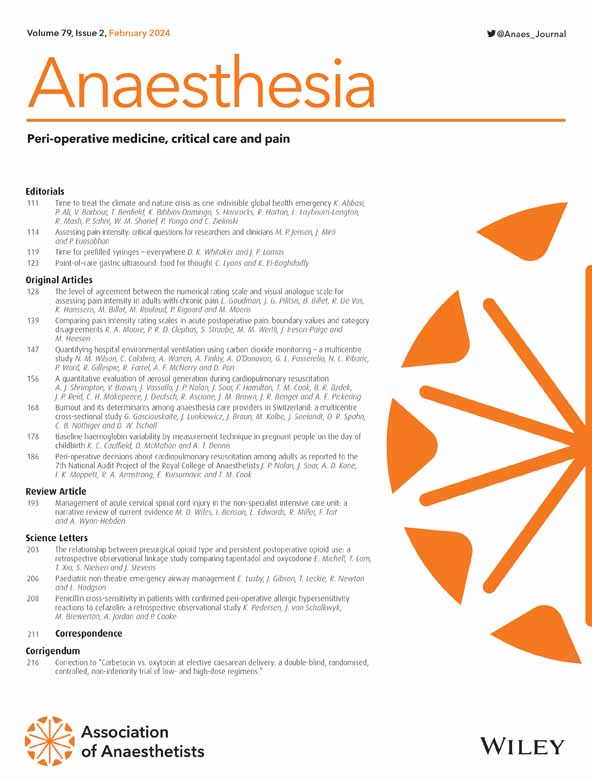Penicillin allergy risk stratification tool for use by non-allergists in the peri-operative setting: an agreement study and qualitative process evaluation.
IF 6.9
1区 医学
Q1 ANESTHESIOLOGY
引用次数: 0
Abstract
INTRODUCTION Many patients are labelled incorrectly as 'penicillin allergic'. This label is associated with poor health outcomes, regardless of whether the allergy is genuine. We designed a study to assess agreement between allergy specialists (consultant allergists or immunologists) and non-allergists when using a risk stratification tool to determine suitability for a penicillin challenge test. METHODS In this two-centre mixed-method study, adult patients undergoing surgery who had been labelled penicillin allergic were assessed by a healthcare professional with no formal allergy training (consultant anaesthetist or peri-operative nurse) and an allergy specialist doctor using the risk stratification tool. Cohen's kappa was used to quantify agreement. We conducted a qualitative process evaluation based on individual and group interviews to explore user experience. RESULTS We recruited 139 patients and 11 healthcare professionals; 101 patients completed both assessments (median (IQR [range]) age was 53 (40-66 [19-86]) y, 71% women). Allergist and non-allergist assessments agreed for 63 (62%) patients. In the remaining 38 (38%), most disagreements represented an overcautious approach by non-allergists, except in seven patients categorised as unsuitable (or uncertain) by the allergist but suitable by the non-allergist. Inter-rater agreement was moderate (unweighted κ 0.43, 95%CI 0.30-0.57; weighted κ 0.47, 95%CI 0.27-0.67). The prevalence and bias-adjusted score indicated poor inter-rater reliability (κ score 0.25, 95%CI 0.06-0.44). Qualitative analysis indicated low confidence in the tool among non-allergists, with a perceived need for allergy training and specialist support. DISCUSSION This penicillin allergy risk stratification tool, designed for use by healthcare professionals with no formal allergy training, showed poor agreement with allergy expert assessments.围手术期非过敏医师使用的青霉素过敏风险分层工具:一项协议研究和定性过程评估。
许多病人被错误地贴上“青霉素过敏”的标签。不管是否真的过敏,这个标签都与不良的健康状况有关。我们设计了一项研究,评估过敏专科医生(过敏症专科医生或免疫学家)和非过敏症专科医生在使用风险分层工具确定青霉素激发试验的适宜性时的一致性。方法在这项双中心混合方法研究中,接受手术的成人患者被标记为青霉素过敏,由未经正式过敏培训的医疗保健专业人员(麻醉顾问医师或围手术期护士)和过敏专科医生使用风险分层工具进行评估。Cohen的kappa被用来量化一致性。我们进行了基于个人和小组访谈的定性过程评估,以探索用户体验。结果共纳入139例患者和11名医护人员;101例患者完成了两项评估(中位(IQR[范围])年龄为53岁(40-66岁[19-86]),71%为女性)。63例(62%)患者的过敏症专家和非过敏症专家评估一致。在剩下的38例(38%)中,除了7例被过敏专科医生归类为不合适(或不确定)但被非过敏专科医生归类为合适的患者外,大多数分歧代表了非过敏专科医生过于谨慎的方法。评分间一致性中等(未加权κ 0.43, 95%CI 0.30-0.57;加权κ 0.47, 95%CI 0.27-0.67)。患病率和偏倚校正评分显示评分间信度较差(κ评分0.25,95%CI 0.06-0.44)。定性分析表明,非过敏症专家对该工具的信心较低,认为需要过敏培训和专家支持。这种青霉素过敏风险分层工具是为没有接受过正式过敏培训的医护人员设计的,与过敏专家的评估结果不一致。
本文章由计算机程序翻译,如有差异,请以英文原文为准。
求助全文
约1分钟内获得全文
求助全文
来源期刊

Anaesthesia
医学-麻醉学
CiteScore
21.20
自引率
9.30%
发文量
300
审稿时长
6 months
期刊介绍:
The official journal of the Association of Anaesthetists is Anaesthesia. It is a comprehensive international publication that covers a wide range of topics. The journal focuses on general and regional anaesthesia, as well as intensive care and pain therapy. It includes original articles that have undergone peer review, covering all aspects of these fields, including research on equipment.
 求助内容:
求助内容: 应助结果提醒方式:
应助结果提醒方式:


